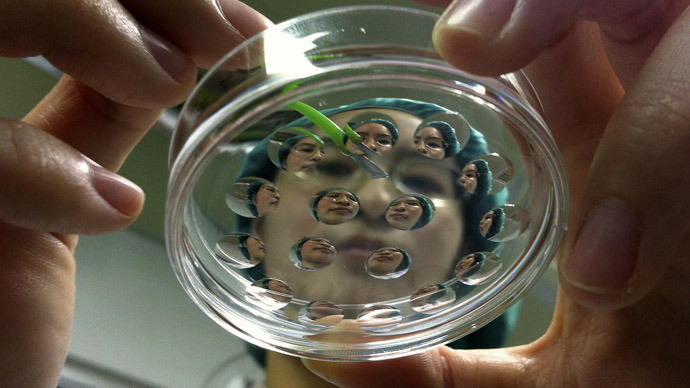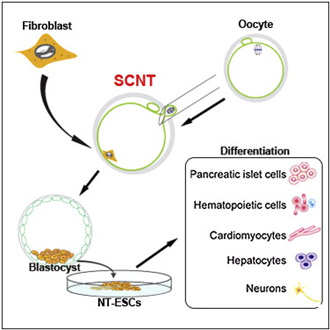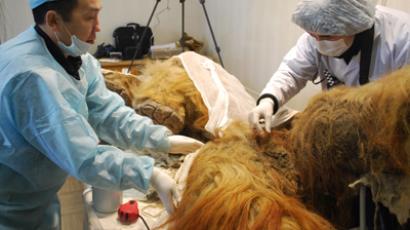Cell out? Successful embryo stem cell cloning draws moral fire

A new landmark stem cell technique in therapeutic cloning opens new horizons in treating rare diseases and disorders caused by gene mutations. Yet, like any kind of human cloning, the research has sparked controversy on either side of the Atlantic.
A decade-long effort of geneticists worldwide has finally been
crowned with success. On May 15, The Cell published report from scientists in
Oregon that they have managed to harvest stem cells from six human
embryos bred from donated eggs.
Two embryos got DNA of a child with a genetic disorder (samples taken from skin cells), and the other four were raised with DNA from fetal skin cells.
Shoukhrat Mitalipov, senior scientist at Oregon Health & Science University, has announced elaboration of a breakthrough technology enabling production of personalized stem cells to cure illnesses with this unique human tissue.
“This [research] represents an unparalleled achievement. They succeeded where many other groups failed, including mine,” stem cell biologist George Daley of the Harvard Stem Cell Institute shared with Reuters.

Some illnesses are caused by genetic disorder, by mutations in mitochondria genes which power cell development. The new technique makes it possible to replace defective with healthy ones by supplying tissue with new mitochondrial genes.
Stem cells can develop into any of the over 200 types of tissue in a human body and replace the diseased tissue with new healthy cells.
Mitalipov and his team have come a long way to achieve the long-expected positive result so much anticipated by the developing stem-cell medical fraternity.
It took six years of experiments with monkey embryos to get positive results with human ones. In 2009, they cloned Macaque monkey twins Mito and Tracker, which brought them worldwide fame for being the first to develop the technology of transplantation of chromosomal complex into primates’ eggs, thus making cloning of a primate - and potentially a human – possible.
At the same time Mitalipov particularly stressed that human embryos made with his technique could not be developed into cloned babies and he has no desire to check this out.
In September 2010 the US Clinical Events Committee granted Mitalipov’s team a license to work with human eggs and embryos. Then there were over two years of hard work that finally ended with a genetic technology breakthrough.
In word the technique is ‘simple’. DNA from a patient is implanted into a human egg, which develop into an early embryo with patient’s DNA. Then the embryo is used to obtain stem cells for treatment of such diseases as multiple sclerosis, Parkinson's disorder, various hereditary heart diseases etc.

The greatest achievement of the method is that the tissues developed with the help of such cells will not be rejected by the patient’s immune system because the genetic match of the tissue will be flawless.
Also, the technique could be put to good use to help potential parents to conceive an absolutely healthy baby without any genetic defects that might endanger the child’s life or make things difficult for the parents if the baby has health problems.
If the results of Oregon research can be repeated in other genetic laboratories, the technique will become the third known method to produce stem cells. One of the other two methods is obtaining stem cells from early human embryos (blastocysts), in large quantities raised in fertility clinics (1998). Another one is the way the famous sheep Dolly was cloned in Scotland back in 1996, when scientists removed DNA from a sheep oocyte (egg), replaced it with DNA from a sheep mammary gland cell and made it grow without being fertilized with sperm.

But like many biotech technologies this one has its dark side, too. The matter is that stem cells harvesting involves destroying of cloned human embryos, a controversial method with far-reaching consequences. Many find such approach unethical and in the face of possible human cloning – even dangerous.
The director of education for National Catholic Bioethics Center, an independent think tank in Philadelphia, Rev. Tad Pacholczyk, told Associated Press that the method involves utilization of “early human beings as repositories for obtaining desired cells.”
“You're creating them only to destroy them,” Pacholczyk said, reiterating Catholic Church’s opposition to embryo cloning.
Marcy Darnovsky, executive director of the Center for Genetics and Society in Berkeley, California, shared with AP that she is glad that Mitalipov is not interested in cloning babies. But the report in The Cell is yet another good reason for the US Federal government to ban human reproduction cloning once and for all, she said.
Same critics come from the other side of the Atlantic, where the British Human Genetics Alert watchdog group protested Shoukhrat Mitalipov’s research even before the study was published in The Cell.
The group's director Dr. David King acknowledged that scientists have finally delivered a method for reliably creating cloned human embryos.
"This makes it imperative that we create an international legal ban on human cloning before any more research like this takes place. It is irresponsible in the extreme to have published this research,” King told Reuters.















